How to Execute Marketing Campaigns with AI: A Practitioner’s Guide
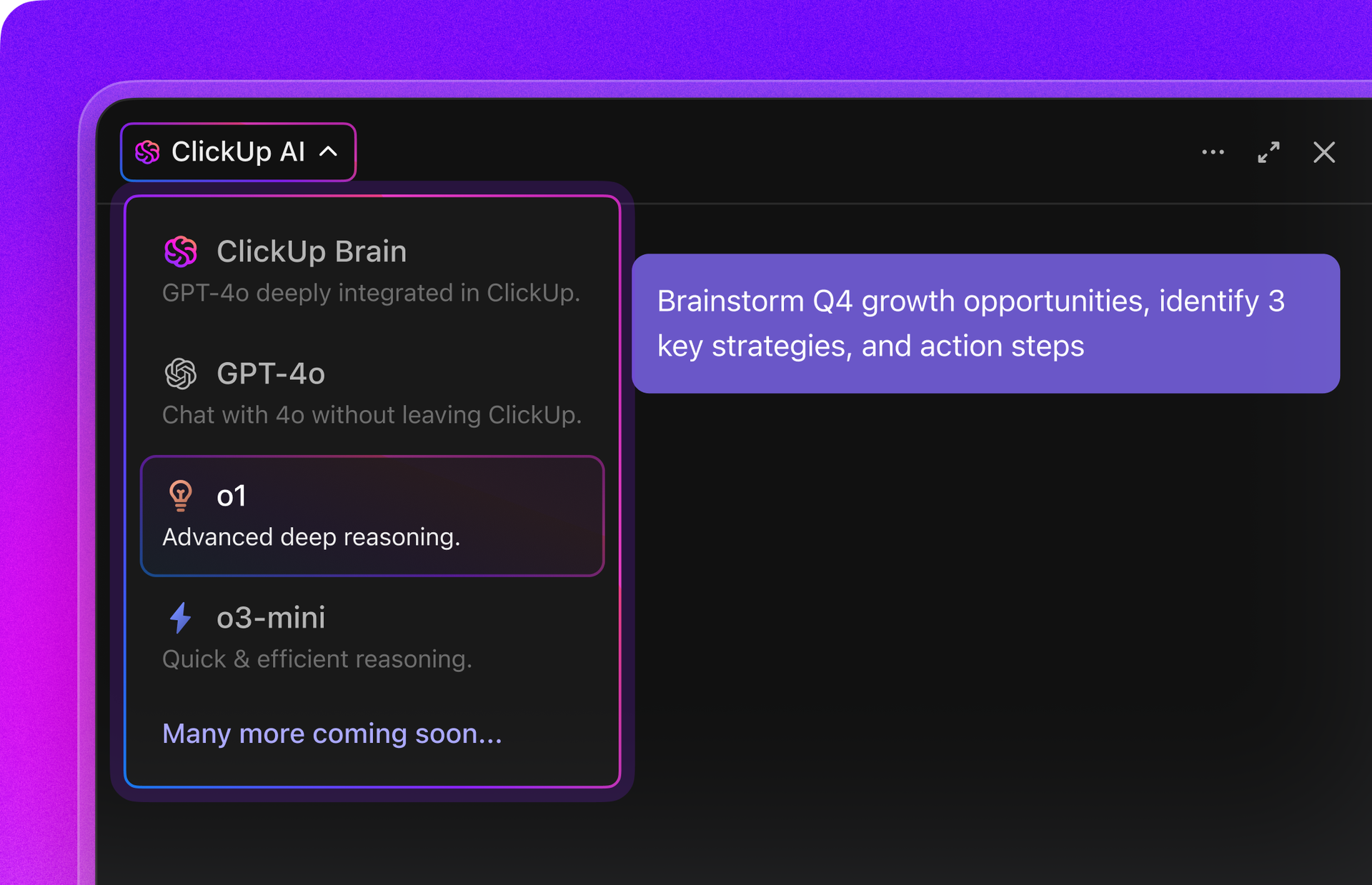
Sorry, there were no results found for “”
Sorry, there were no results found for “”
Sorry, there were no results found for “”

If you’re like most marketers, you’re spending too much time managing campaigns and not enough time executing them. With deadlines tightening and expectations growing, the traditional approach to marketing campaigns just isn’t cutting it.
Artificial intelligence is changing the game for marketing teams.
By automating repetitive tasks and streamlining workflows, artificial intelligence helps you create and execute campaigns faster, with better results. This guide explores practical steps to automate your marketing campaign creation using AI tools, with a focus on implementation rather than theory.
AI campaign execution uses artificial intelligence to automatically plan, manage, and optimize marketing campaigns across multiple channels. By analyzing data in real time, AI can make intelligent decisions about who to target, what message to deliver, when, and through which channel—enabling faster, smarter, and more personalized marketing at scale.
At its core, AI campaign execution transforms traditional marketing by infusing it with data-driven precision and adaptability.
AI-powered campaign execution combines technologies like large language models (LLMs), machine learning, natural language processing, and predictive analytics. This goes beyond basic automation—enabling dynamic content delivery, accurate performance forecasting, real-time campaign optimization, and precise audience targeting.
❗️One key detail, though: AI-driven campaign execution isn’t here to replace marketers. By handling repetitive tasks and surfacing actionable insights, AI empowers marketing teams to focus more on creativity and the strategy side of things!
In fact, our AI Usage Gap Report from ClickUp Insights found that 30% of respondents use AI-powered tools for research and information gathering, streamlining campaign execution with faster access to insights. Meanwhile, 11% leverage AI primarily for brainstorming and ideation, accelerating the creative process from concept to action.
Great campaigns win by seizing the moment—whether it’s jumping on a viral trend or reacting quickly to a market shift. That takes speed, scale, and razor-sharp precision.
AI technologies and AI tools excel at all of this, helping marketers and revenue leaders execute faster.
Here’s a quick breakdown of why AI campaign execution matters, especially when facing budget constraints and the need to do more with fewer resources:
| Benefit | What it means | Example |
|---|---|---|
| Speed and efficiency | AI works with raw data in real time, shortening the gap between insight and action. | An eCommerce brand uses AI models to detect a spike in interest and launches a flash sale campaign within minutes. |
| Personalization at scale | AI tailors marketing copy for millions based on user behavior, preferences, and journey stage. | A streaming service uses semantic analysis to recommend different trailers based on watch history and time of day. |
| Data-driven decisions | AI bases actions on real insights—not assumptions—leading to more accurate insights. | A retail chain tests two email campaigns and automatically sends the top-performing one to the rest of the list. |
| Smarter budget allocation | AI reallocates spend to the highest-performing variations, creatives, or audiences during a campaign. | A DTC skincare brand shifts spend from Instagram to TikTok mid-campaign after detecting higher ROI. |
| Continuous learning | AI systems learn and adapt over time, improving content production and performance with every campaign. | A travel app uses generative AI to refine seasonal promotions each year, increasing bookings consistently. |
By using AI for data collection, campaign execution, and performance analysis, marketers can deliver a measurable impact, maximize ROI, and fuel creative development—all while working with limited time and resources.
Your marketing team faces a familiar challenge: too many tools, too many meetings, and not enough time to focus on strategic and creative work. Let’s break down the specific hurdles:
How much time did your team spend last week just coordinating campaign tasks rather than creating?
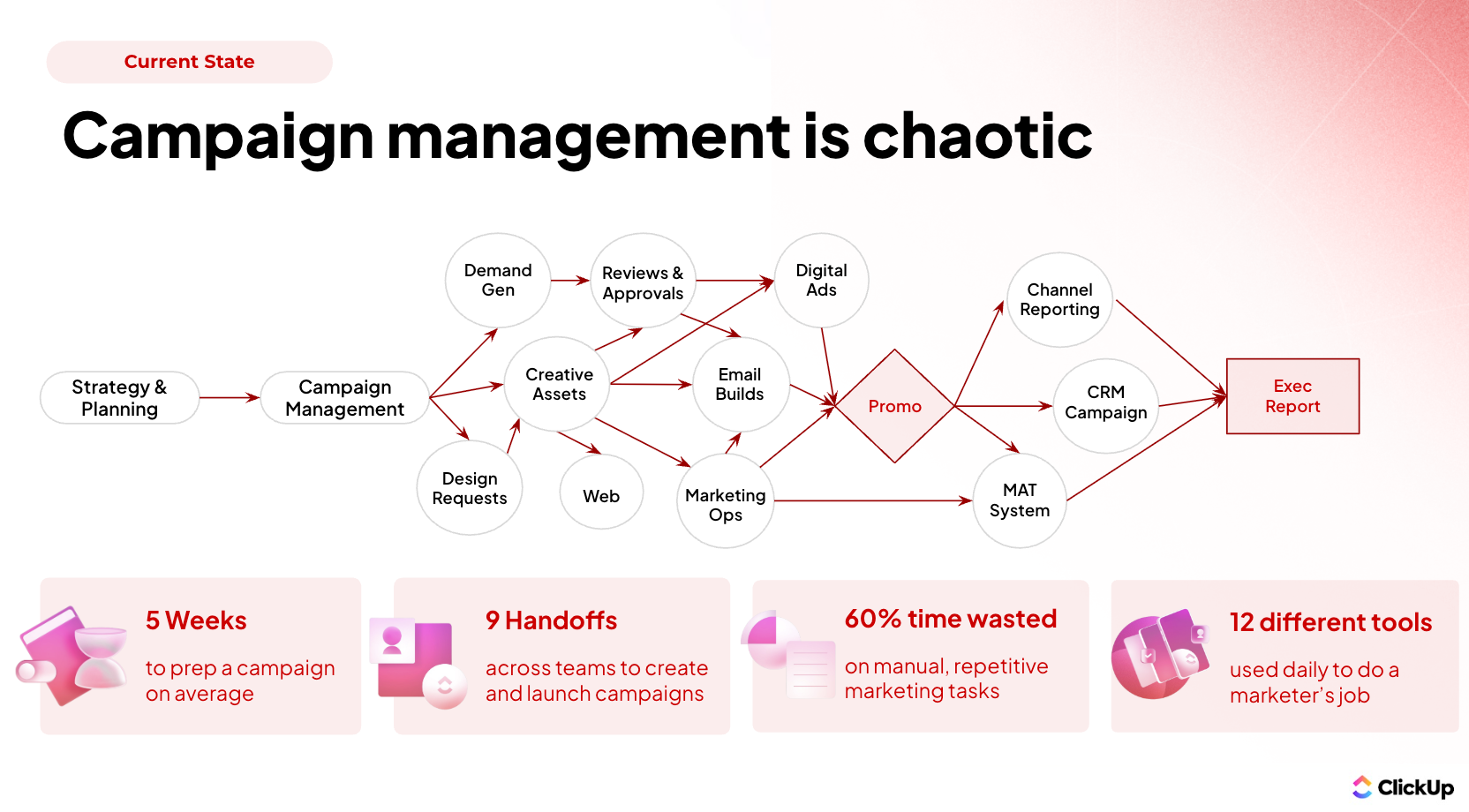
Spreadsheets might be your go-to tool for campaign management, but they’re limiting your team’s potential.
Here’s why:
Without built-in support for content optimization, spreadsheets simply can’t support the complexity of modern marketing campaigns.
You’ve likely tried using general project management tools for marketing campaigns. While better than spreadsheets, they still have significant limitations:
In the age of artificial intelligence, sticking with traditional systems means you’re not taking advantage of automation that could dramatically increase your team’s output. The status quo approach simply can’t meet the expectations that marketing and company leaders have around marketing velocity.
At the end of the day, the real question is ROI.
Manual processes are slow, but they are also expensive. They cost you more in time, missed opportunities, and wasted resources.
AI-powered campaign execution flips that equation. It boosts efficiency, reduces errors, accelerates speed to market, and drives better performance with less effort.
Here’s a breakdown of how AI compares to manual execution across key areas—and how it directly impacts your bottom line.
| Category | Manual campaign execution | AI-powered campaign execution | ROI impact |
|---|---|---|---|
| Workflow efficiency | Fragmented tools and manual coordination slow everything down | Centralized, automated workflows eliminate redundancies | AI cuts coordination time, freeing teams to focus on high-value work |
| Data handling | Manual entry leads to errors and outdated info | Real-time syncing and data integrity across systems | Reduces costly mistakes and improves decision-making speed |
| Personalization | Generic messaging due to lack of time and scale | Hyper-personalized messaging at scale | Increases engagement and conversion rates |
| Speed & agility | Slow feedback loops and delayed execution | Instant optimization based on live data | AI tools recommend the best content, timing, and targeting |
| Tool limitations | Spreadsheets and generic tools lack campaign intelligence | AI tools can analyze data and make recommendations for content, timing, and targeting | Improves campaign performance with less manual effort |
| Creative workflow Support | Disconnected approval processes and limited asset visibility | Automated workflows with integrated asset libraries | Speeds up creative cycles and reduces production delays |
| Visibility & reporting | No live tracking; insights lag behind performance | Real-time dashboards and predictive insights | Enables proactive, data-driven adjustments for better ROI |
| Scalability | Resource-intensive to scale across channels or regions | AI scales campaigns without added manual workload | Supports business growth without proportional cost increase |
| Team focus | Time wasted on admin and project tracking | More time spent on strategy, ideation, and innovation | Higher-value work improves team output and campaign success |
Start by evaluating tools that will actually solve your specific campaign challenges. Look for platforms that offer:
What are the most time-consuming aspects of your current campaign process that AI could help automate?
For most marketers, the response would be context. That may mean training the AI on your materials, feeding your brand messaging, etc. But with ClickUp Brain, all that context is built in. 👇🏼
💡Pro Tip: Here’s how our teams at ClickUp plan their marketing campaigns end-to-end. Hear it from Mike, one of our Strategic Solutions Engineers.👇🏼
Successful implementation requires seamless connection with your current tools:
This integration step is crucial—it creates a central hub for campaign data while allowing specialized tools to do what they do best.
As the everything app for work, ClickUp’s Marketing suite brings your marketing campaign tools, ranging from CRM to dashboards to third-party tools, under a single, unified platform. Here’s what such a workflow looks like in practice:
AI enables more strategic and data-driven marketing budget allocation by forecasting campaign outcomes before you spend a dollar.
It could look like:
Even with AI, effective campaign planning starts with human strategy:
This approach turns a traditionally time-consuming process into an efficient collaboration that leverages both human expertise and a well-structured AI marketing strategy.
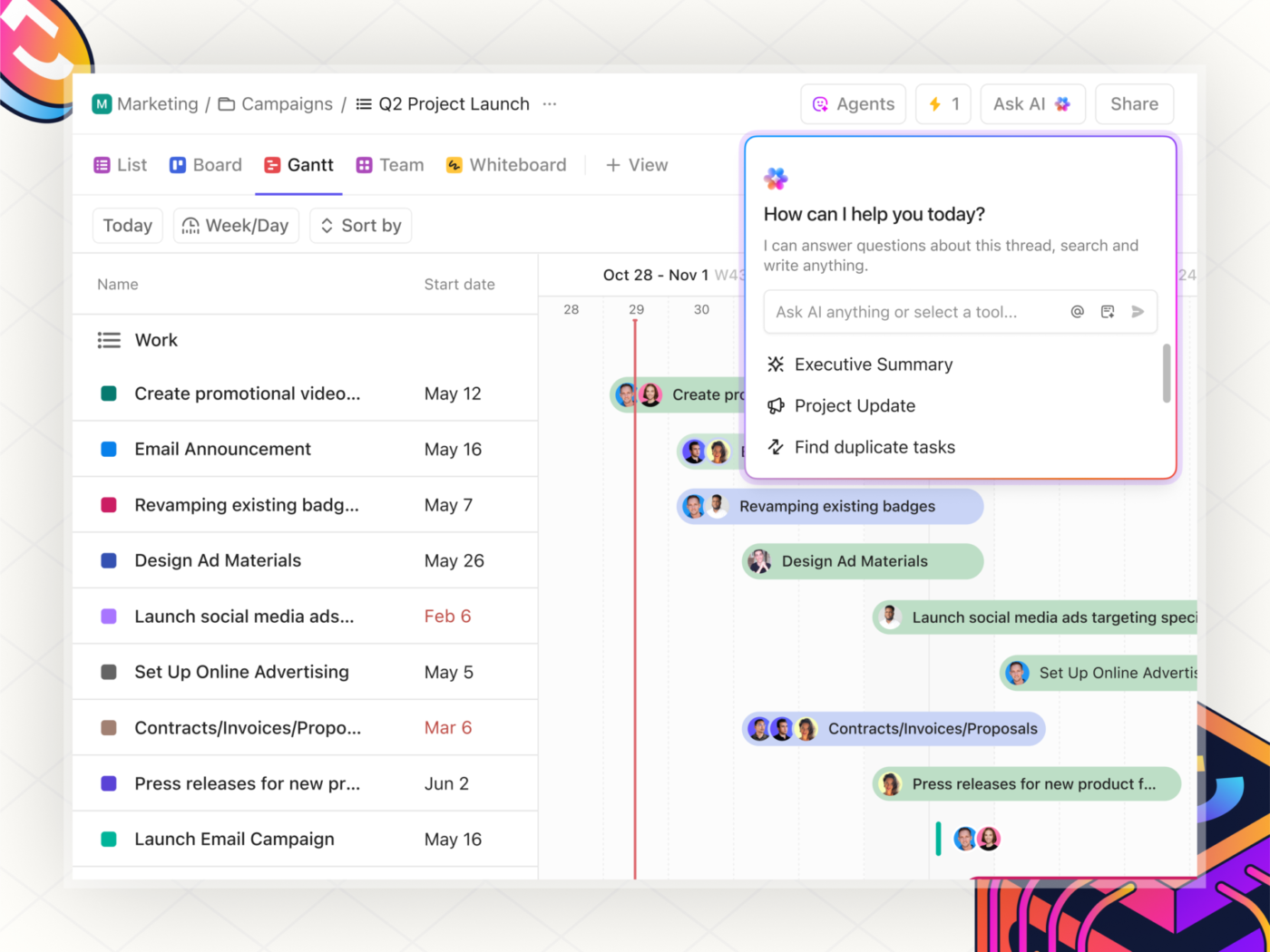
With your campaign brief ready, it’s time to leverage AI for execution:
By automating these repetitive tasks, your team can focus on strategic refinement rather than starting from scratch with each asset.
Many modern tools use generative AI to accelerate the production of content while maintaining brand consistency. Here’s an example from ClickUp Brain:
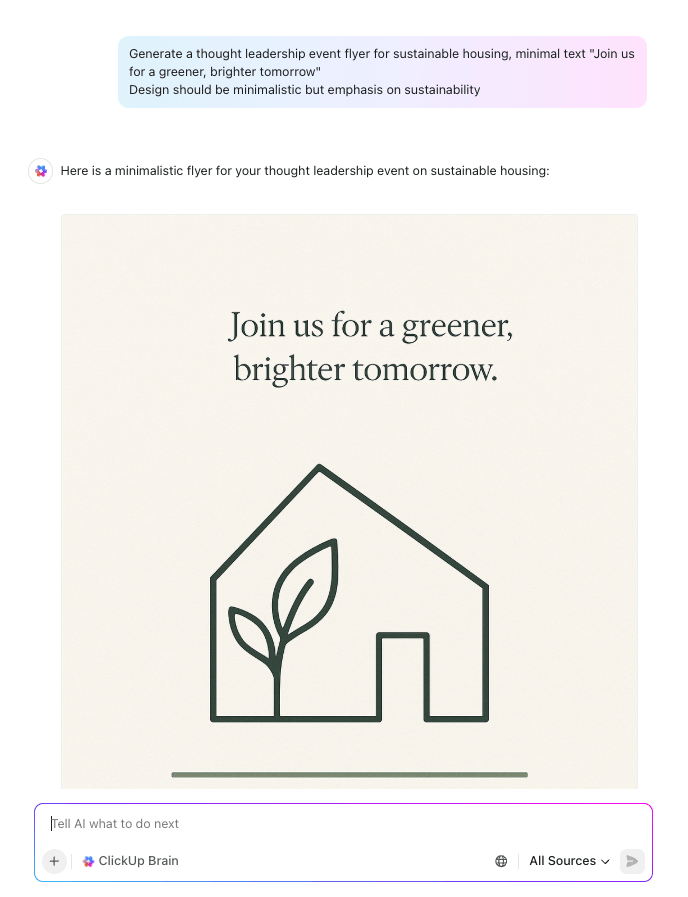
📖 Read More: How to Use AI in Advertising (Use Cases & Tools)
AI transforms campaign monitoring from reactive to proactive:
This ongoing optimization ensures you’re not just automating campaign creation but continuously improving results.
One of the biggest wins from AI here is eliminating siloed updates.
The last thing your marketing team wants is to waste hours toggling between ten dashboards across five different tools, trying to piece together campaign performance, asset status, and customer insights. With ClickUp’s AI card summaries, you get instant, actionable insights from all your connected tools—right where you work.
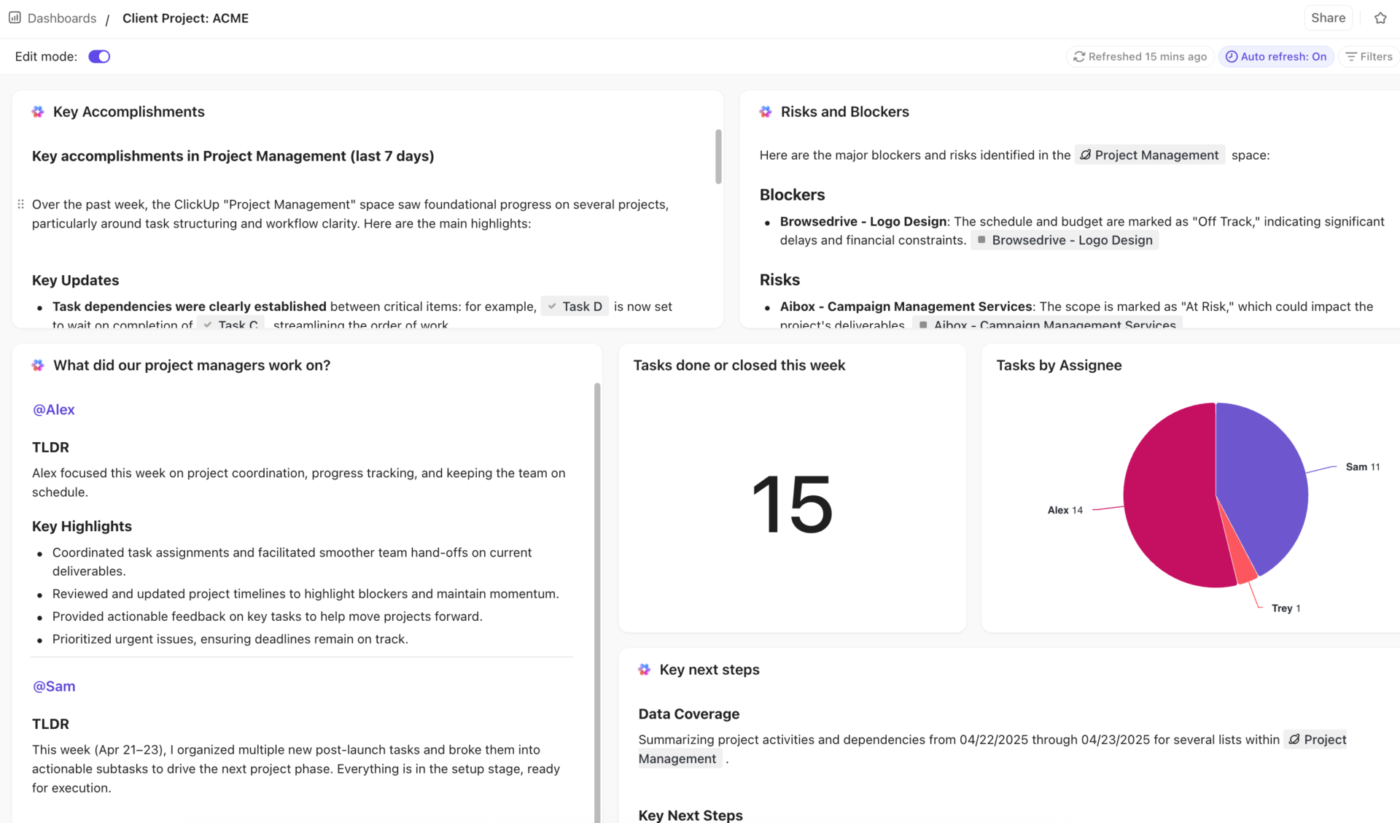
Remote marketing teams often struggle with fragmented communication, missed deadlines, and inconsistent messaging. AI solves these challenges by creating a connected, context-rich workspace where collaboration becomes seamless.
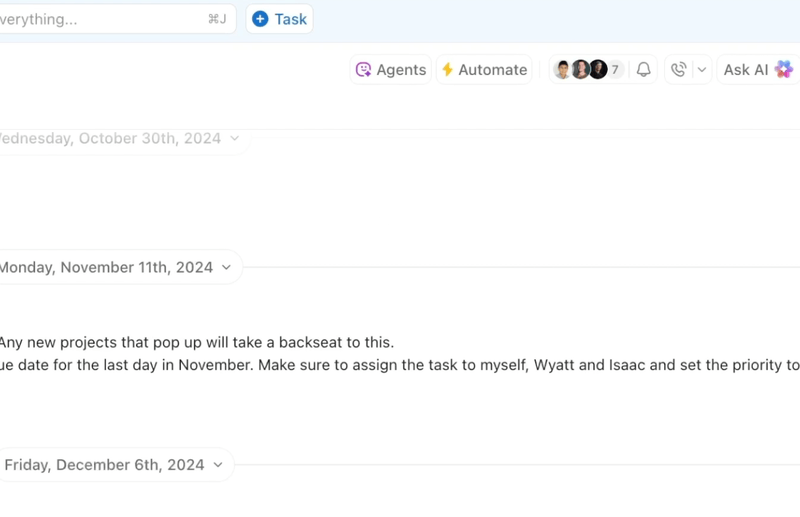
A key advantage of integrating AI into your marketing campaigns is the ability to measure and optimize return on investment (ROI) with precision.
To fully leverage AI’s potential, it’s essential to track a comprehensive set of KPIs and metrics that capture campaign outcomes, operational efficiency, and predictive insights.
| Metric | Description | AI impact/benefit |
|---|---|---|
| Conversion Rate (CVR) | Percentage of prospects taking a desired action (purchase, sign-up, etc.) | Improves targeting and personalization, indicating effective AI-driven audience segmentation and messaging |
| Cost Per Acquisition (CPA) | Average cost to acquire one customer | AI optimizes budget allocation toward high-performing channels to reduce CPA while maintaining/increasing volume |
| Return on Ad Spend (ROAS) | Revenue generated per dollar spent on advertising | AI identifies the most profitable campaigns, maximizing profitability |
| Campaign Velocity | Speed from campaign concept to execution and results | AI automation accelerates approvals and streamlines workflows, demonstrating efficiency gains |
| Engagement Rate | Click-through rates, email open rates, social shares, time spent on assets | AI-driven dynamic content personalization improves engagement and campaign resonance |
| Lead Quality Score | Scoring leads based on conversion likelihood using behavior and interaction data | AI enables focus on high-potential prospects, increasing sales efficiency |
| Predictive Analytics Accuracy | Accuracy of AI forecasts for campaign performance (conversions, revenue, etc.) | Reflects the maturity of AI models and informs strategic decisions |
| Operational Efficiency | Reductions in manual effort, approval times, and error rates | Marketing automation with AI saves time and cost, enabling focus on strategic initiatives |
| Customer Lifetime Value (CLV) | Revenue expected from a customer over their lifetime | AI personalization improves retention and upselling, driving long-term revenue growth |
| Funnel Drop-Off Rates | Points in the funnel where prospects disengage | AI insights reveal drop-off patterns and suggest interventions to improve conversion flow |
ClickUp’s no-code Dashboards provide a centralized, customizable hub to monitor all these KPIs in real time. By integrating data from ad platforms, CRM systems, email marketing tools, and analytics, ClickUp surfaces AI-driven insights and visualizations that help you:

📖 Read More: 40+ Marketing KPIs To Help You Crush Your Goals
Ready to transform your campaign process? Here’s a practical 30-day plan:
📖 Read More: How to Create a Marketing Campaign Checklist
ClickUp’s Campaign Execution solution addresses the inefficiencies of traditional approaches by consolidating planning, execution, and tracking into a single platform:
This consolidation of workflows fundamentally transforms team collaboration and campaign success by freeing creative teams from administrative tasks and allowing marketers to focus on crafting compelling content rather than managing spreadsheets. Think of it as your end-to-end AI campaign planner and executor, all rolled into one.
HubSpot is a solid marketing automation platform that uses AI to personalize and scale your campaigns effectively. It supports everything from content creation to lead nurturing and campaign reporting.
HubSpot’s AI features help optimize email send times, segment audiences automatically, and power chatbots that engage visitors in real time. It also offers predictive lead scoring to identify high-converting contacts, making campaign follow-ups more strategic and efficient.
Marketo is built for enterprise-level marketing teams looking to manage complex, multi-touch campaigns. Its AI capabilities shine in predictive content delivery and behavioral analysis, helping marketers serve the most relevant messaging to each segment.
The platform excels in B2B campaign execution with features like adaptive personalization, account-based marketing, and advanced analytics. Marketo’s AI tools also learn from past campaign performance to suggest data-backed improvements.
Salesforce’s Marketing Cloud is a robust solution to deliver personalized campaigns across email, mobile, social, and web. Its built-in Einstein AI engine provides powerful features such as predictive audience targeting, journey optimization, and automated engagement.
Campaign managers can use its AI to identify which content will resonate most, optimize touchpoints, and track customer journeys in real time—all within the Salesforce ecosystem, which is ideal for sales-aligned marketing efforts.
Mailchimp is known for its user-friendly interface and accessible AI campaign management tools. It provides smart content suggestions, optimized send times, and predictive audience insights that help refine messaging.
Its Creative Assistant uses AI to generate on-brand visuals and email designs quickly. Mailchimp is a go-to choice for marketers who want fast, data-driven results without a steep learning curve.
Persado stands out by using AI to generate and optimize campaign language based on emotional and psychological triggers. Rather than just assisting with automation, Persado focuses on crafting high-performing messages by analyzing historical campaign data and user engagement.
It helps marketers fine-tune subject lines, headlines, and calls to action, resulting in improved click-through and conversion rates. It’s a perfect fit for teams prioritizing high-impact messaging.
Drift transforms the traditional campaign funnel using conversational AI to create real-time engagement with website visitors. Its chatbots can answer questions, qualify leads, schedule meetings, and route conversations to the right teams—all without human intervention.
This makes Drift especially valuable for B2B marketers looking to reduce friction and shorten sales cycles. Campaign managers can also use Drift’s insights to refine future campaigns based on user interaction data.
ActiveCampaign blends AI-enhanced CRM capabilities with email and SMS campaign automation. The platform uses machine learning to assign win probabilities to leads, predict the best time to send messages, and trigger workflows based on customer behavior.
Its segmentation tools allow marketers to create highly targeted campaigns that adapt based on engagement patterns. ActiveCampaign is particularly effective for nurturing relationships across long customer journeys.
Influencity is an AI-powered influencer marketing platform that simplifies the process of running scalable, data-driven influencer campaigns. It helps brands identify relevant influencers, verify audience authenticity, and forecast campaign outcomes based on engagement metrics.
Its AI tools analyze follower demographics and behavior to ensure alignment with your campaign goals. This platform is ideal for marketers aiming to combine influencer reach with measurable performance data.
Adverity is a powerful AI-driven platform for marketing data integration and analytics. It enables campaign managers to connect multiple data sources, track KPIs in real time, and surface actionable insights using predictive modeling.
The platform’s AI identifies anomalies, trends, and optimization opportunities across campaigns, helping teams fine-tune their strategies without drowning in spreadsheets. This is especially valuable for large organizations managing multichannel campaigns.
📖 Read More: Best Campaign Management Software Tools
AI can do a lot, but scattered efforts with AI just won’t do. For consistent results, you need a solid, repeatable process.
Whether launching a new product, managing complex marketing planning processes, or monitoring campaign performance, these templates provide a structured and easy-to-use framework so your team can stay aligned, organized, and focused on what matters most.
This Campaign Plan Template from ClickUp is your blueprint for success, designed to help you outline every critical detail of your marketing campaign—from goals and target audience to key messaging and timelines. It keeps your strategy clear and actionable, making it easy to align your team around shared objectives.
💫 Why you’ll love this template
Take full control of your marketing campaigns with ClickUp’s Marketing Campaign Management Template. It’s built to simplify campaign execution by organizing tasks, budgets, and deadlines in a centralized hub.
💫 Why you’ll love this template
Keep a finger on the pulse of your campaigns with this intuitive Campaign Tracking Template. Monitor performance metrics, analyze results, and generate insights to optimize your marketing efforts—without the hassle of juggling multiple tools or spreadsheets.
💫 Why you’ll love this template
⚡️ Template Archive: Free Marketing Plan Templates to Build a Marketing Strategy
With the process and framework in place, it’s time to look at some real-world challenges of using AI in campaign execution. From messy data to tone-deaf messaging, a few common issues can trip teams up if they’re not prepared.
| Challenge | What does it mean |
|---|---|
| Data dependency | AI systems are only as good as the data they’re fed. Poor data quality, siloed systems, or biased training sets can limit AI’s effectiveness or lead to flawed outputs. |
| Lack of human context | AI can optimize based on performance metrics, but it lacks emotional intelligence and cultural context. Without human oversight, this can result in tone-deaf messaging or misaligned creative decisions. |
| Black box decision-making | Some AI tools offer little visibility into why they make certain recommendations. This opacity can make it hard for teams to trust or validate AI-driven decisions. |
| Over-reliance on automation | When teams over-automate, creativity and empathy can suffer. It’s essential to strike a balance between intelligent automation and human strategy. |
| Implementation complexity | Integrating AI into existing workflows often requires change management, new skill sets, and updated governance processes—which can slow down adoption or create friction. |
| Ethical concerns | AI can unintentionally reinforce biases or deliver overly intrusive experiences if not carefully managed. Ethical considerations should be part of every AI campaign initiative. |
To unlock the full value of AI while avoiding common pitfalls, teams should follow structured best practices that balance innovation with responsibility.
Don’t implement AI for the sake of it. Ensure it supports broader business objectives—whether it’s faster execution, smarter targeting, or improved ROI.
✅ Done right: A retail brand uses AI-driven predictive analytics to send personalized cart abandonment reminders, directly boosting sales conversions
❌ Gone wrong: A company invests in AI chatbots without a clear plan to handle high-touch and low-touch support tickets, leading to poor customer experiences and wasted resources
Let AI handle data processing, optimization, and scaling—but keep humans in the loop for storytelling, creative direction, and brand alignment.
✅ Done right: AI generates multiple ad variants; marketing experts review and select ones that match brand tone and emotional impact
❌ Gone wrong: Fully automating social media content without human review causes off-brand posts and public backlash
Feed AI systems with accurate, clean, and representative data. Avoid datasets that could introduce bias or skew targeting unfairly.
✅ Done right: Hiring AI trained on diverse candidate data fairly assesses applicants from all demographics
❌ Gone wrong: AI trained on biased historical hiring data excludes qualified candidates from underrepresented groups
AI is not a set-it-and-forget-it solution. Track performance, question results, and iterate regularly to improve both models and outcomes.
✅ Done right: Fraud detection AI is regularly updated with new data to maintain accuracy and catch evolving threats
❌ Gone wrong: AI is launched and never updated, missing new fraud patterns and increasing risk exposure
Ethical marketing requires more than just compliance. Here are some proactive Dos and Don’ts to consider in your AI-powered marketing campaigns
AI campaign execution is adaptable to a wide range of marketing goals. Here are three scenarios where it adds exceptional value:
Launching a new product demands speed, precision, and personalization—all strengths of AI.
AI can help you:
Whether it’s a webinar, conference, or product demo, events require tight coordination and a targeted promotion strategy. AI helps by:
With ClickUp, we can show what’s happened with our marketing initiatives in a regional view or a campaign view. This includes looking at what types of activities we’re running and what funnel stage we’ve tagged them to. This way, senior management can easily get up to speed on a project’s status.
For nonprofits with lean teams and big missions, AI offers cost-effective campaign support:
This helps nonprofits maximize their reach and results—without increasing overhead.
✅ Data privacy checklist for AI-driven marketing campaigns
AI can supercharge your marketing—but only if it’s grounded in responsible data practices. Use this checklist to make sure your campaigns respect privacy and build trust:
Strong privacy practices go beyond avoiding legal trouble—they’re key to building long-term customer trust.
In 2024, brands that went big didn’t just use AI for campaign execution—they moved faster, tapped into cultural momentum, and maximized their impact by working with real-time data, trends, and generative tools.
These standout campaigns show how AI can unlock hyper-relevant messaging, personalized experiences, and viral creative—all executed at unprecedented speed.
In 2024, Coca-Cola took on the technology by reimagining its iconic “Holidays Are Coming” campaign. This move marked a significant departure from traditional advertising templates and formats, blending the brand’s rich heritage with cutting-edge technology.
Beyond television commercials, Coca-Cola expanded its AI initiative to engage consumers directly. Through the “Create Real Magic” platform, users could interact with a digital Santa Claus, share holiday memories, and receive personalized snow globe animations.
This interactive experience was powered by AI models developed in collaboration with Accenture, Microsoft, Leonardo.ai, Mimic, and OpenAI.
In 2024, Tombras partnered with PODS and Google’s Gemini AI to launch what they called “the world’s smartest billboard”—a groundbreaking weather- and context-aware advertising campaign.
PODS moving trucks in New York City were outfitted with digital screens that displayed real-time, hyper-localized ads generated by Gemini AI.
Using Google Cloud, Vertex AI, and live GPS data, the system created over 6,000 unique copy lines tailored to nearly 300 neighborhoods, reacting dynamically to weather, traffic, time of day, and even local events. The campaign led to a 60% increase in website sessions, a 33% jump in quote requests, and over 5 million impressions in just 29 hours—delivering PODS’s best week in NYC for 2024.
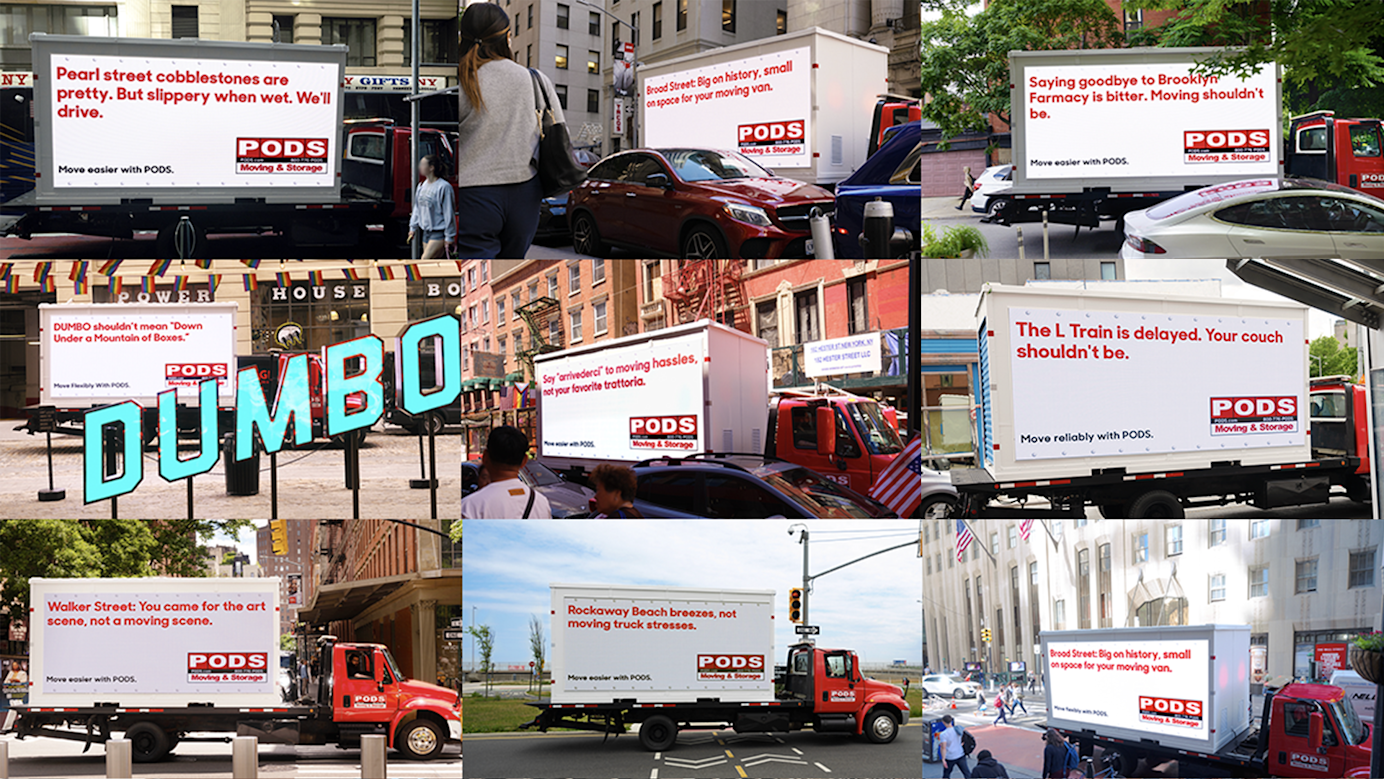
Fiverr’s “Nobody Cares” Campaign (2024) is a bold, satirical musical ad mocking the overuse of AI as a selling point. Through catchy Broadway-style tunes, it drives home one message: nobody cares if you used AI—only if the result works.
Launched alongside Fiverr’s 2024 Generative AI Usage Report, the campaign highlighted that 63% of freelancers now use AI tools (up from 58% in 2023), with ChatGPT (88%), Midjourney (37%), and Firefly (29%) being the most used.
🌼 Callout: The campaign itself leveraged AI to rapidly generate scripts, visuals, and assets—demonstrating how AI is becoming integral to messaging and creative execution at speed and scale.
KitKat’s 2024 “Have AI Break” campaign turned a real Google DeepMind insight—that AI gives better answers after being told to “take a break”—into a viral moment.
By prompting AI with “Have a break, and then…”, KitKat showed improved results in side-by-side comparisons, tying its iconic slogan to smarter AI use. The playful video drove 3.5B+ impressions, 18x social engagement, 850% boost in positive sentiment, and 14% lift in purchase intent—proving that even AI works better after a KitKat break.
AI in marketing is evolving rapidly—from simple automation to intelligent orchestration across entire customer journeys. Here are the key trends shaping the future of AI campaign execution and what marketers should prepare for:
As AI models grow more sophisticated, personalization will go beyond name and demographic targeting. Future campaigns will adapt in real time to individual behavior, preferences, and even emotional context—creating deeply personalized experiences across every touchpoint.
Rather than reacting to performance data, AI will increasingly anticipate what’s likely to happen—and recommend exactly what to do next. Expect tools that suggest what to optimize and how to do it for the best outcome before issues arise.
With advances in generative AI (text, image, video, and audio), marketers will be able to create entire campaign assets from a single prompt. AI tools will co-create branded content, generate variations for A/B testing, and adapt messaging for different platforms automatically.
AI for marketing campaign optimization will enable campaigns to be managed holistically across email, social, paid, SMS, and web—responding in real time to customer interactions. This dynamic execution will replace static, channel-specific strategies.
As automation becomes more powerful, transparency and ethical use will be front and center. Expect built-in tools for bias detection, model auditing, and explainability to ensure responsible AI marketing campaign practices.
With third-party cookies on the way out, AI will become key in maximizing the value of zero- and first-party data. Smart systems will identify patterns in consented data to fuel personalized, privacy-respecting campaigns.
Automating marketing campaigns with AI isn’t just about efficiency—it’s about creating a competitive advantage in a world where marketing velocity increasingly determines success.
By implementing the right tools and processes, you can transform your team from campaign managers to campaign executors, dramatically increasing output while maintaining quality. The most successful teams aren’t just planning better campaigns—they’re executing them faster and more effectively with artificial intelligence as their co-pilot.
The question isn’t whether to adopt AI-powered campaign automation, but how quickly you can implement it to stay ahead of competitors who are already making the shift.
About ClickUp’s Campaign Execution Solution
ClickUp offers a comprehensive platform that brings campaign planning, content creation, and performance tracking into one unified workspace.
With AI-powered automation and marketing-specific features, ClickUp helps teams eliminate the chaos of campaign management and focus on delivering results.
What skills do marketing teams need to implement AI campaigns?
Marketing teams need a combination of skills to successfully implement AI campaigns. These include data literacy to understand and interpret AI-driven insights, familiarity with AI-powered tools and platforms, analytical thinking to make data-informed decisions, and creativity to develop compelling campaigns. Additionally, skills in project management and cross-functional collaboration are essential to integrate AI smoothly into existing workflows.
How to train your team on AI campaign tools?
Training your team on AI campaign tools starts with providing hands-on workshops and live demonstrations to build practical experience. Supplement this with access to online tutorials, courses, and documentation tailored to your specific tools. Encourage continuous learning by fostering a culture where team members share insights and best practices. Collaborate closely with data scientists or IT experts to bridge technical knowledge gaps and ensure everyone understands how to leverage AI effectively in their roles.
What is the role of AI in ABM campaign execution?
In Account-Based Marketing (ABM), AI plays a crucial role by automating personalization at scale, analyzing large volumes of account data to identify high-potential targets, and optimizing outreach strategies based on engagement patterns. AI tools can help tailor messaging to specific decision-makers, predict account behavior, and streamline campaign workflows. This leads to more efficient resource allocation, higher engagement rates, and improved overall campaign performance.
How much does implementing AI in marketing campaigns typically cost?
The cost of implementing AI in marketing campaigns can vary significantly based on factors like the choice of AI platforms, the scale of campaigns, and the level of customization required. Small to mid-sized businesses might spend on subscription-based AI tools that are affordable and scalable, often ranging from a few hundred to a few thousand dollars per month. Larger enterprises may invest in custom AI solutions and integrations, with costs reaching tens or hundreds of thousands annually. It’s important to evaluate ROI when budgeting for AI adoption.
Can small businesses benefit from AI campaign execution?
Yes, small businesses can greatly benefit from AI campaign execution. AI-powered tools can automate time-consuming tasks such as lead scoring, email personalization, and performance tracking, allowing small teams to work more efficiently. These tools often come with user-friendly interfaces and affordable pricing, making advanced marketing capabilities accessible. By leveraging AI, small businesses can compete more effectively, optimize marketing spend, and drive better results without needing large budgets or extensive technical expertise.
How does AI campaign execution impact the role of marketers?
AI fundamentally transforms the role of marketers by automating routine, data-intensive tasks such as data analysis, reporting, and segmentation. This shift allows marketers to focus more on strategic activities like creative development, campaign planning, and building customer relationships. Marketers become more data-driven, using AI-generated insights to inform decision-making and continuously optimize campaigns. Rather than replacing marketers, AI acts as a powerful tool that amplifies their impact.
How long does it take to see results from AI campaign execution?
The time required to see results from AI campaign execution depends on several factors, including campaign complexity, data quality, and the specific AI tools used. Generally, businesses can start observing improvements within a few weeks as AI begins optimizing targeting and automating workflows. More significant insights and ROI gains typically become apparent over several months, especially as the AI models learn and adapt to new data. Patience and consistent monitoring are key to maximizing results.
How much time can AI save in campaign setup and reporting?
AI can dramatically reduce the time spent on campaign setup and reporting by automating repetitive processes such as data aggregation, segmentation, and generating performance reports. Studies suggest AI can help professionals save up to 12 hours per week. This time savings enables teams to launch campaigns faster, respond more quickly to market changes, and spend more effort on creative and strategic work rather than manual administration.
Does AI replace human marketing work or just augment it?
AI primarily serves to augment human marketing work rather than replace it. While AI excels at processing large datasets, automating routine tasks, and generating insights, it lacks the creativity, intuition, and emotional intelligence that human marketers bring to the table. Successful marketing requires both data-driven precision and human creativity, making AI a powerful partner that enhances marketers’ capabilities instead of substituting them.
What should I do to maintain data quality for AI execution?
Maintaining high-quality data is essential for effective AI execution. Start by implementing strict data collection standards to ensure accuracy and completeness. Regularly clean your datasets to remove duplicates, errors, and outdated information. Establish clear data governance policies that define who is responsible for data management and how data privacy is maintained. Additionally, continually monitor data inputs and AI outputs to detect anomalies and adjust as needed. High-quality data ensures AI tools can provide reliable insights and drive meaningful campaign improvements.
© 2026 ClickUp